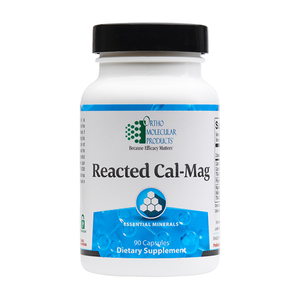
Reacted Cal-Mag, 90 caps
DESCRIPTION
Reacted Cal-Mag provides 200 mg of elemental calcium and 175 mg of elemental magnesium per serving, each ideally formulated using three mineral forms to ensure maximum absorption. While most mineral supplements use only a single source of minerals, which can easily overwhelm a single pathway of absorption and limit uptake, Reacted Cal-Mag leverages the benefit of multiple pathways of absorption by using three different mineral forms.
- Provides Three Forms of Highly Absorbed Calcium & Magnesium for a Variety of Protocols
- High-Concentration Calcium & Magnesium for Cardiovascular Support
- Helps Maintain Healthy Blood Pressure and Glucose Levels
- Promotes Energy Production and Muscle Relaxation
INGREDIENTS
Ingredients:
Calcium is required for heart health, muscle function, nerve transmission, intracellular signaling and hormonal secretion. It is less than 1 % of total body calcium that supports these critical metabolic functions. Serum calcium is very tightly regulated and does not fluctuate with changes in dietary intakes. The body uses bone tissue as a reservoir for calcium, as well as a source of calcium, to maintain constant concentrations of calcium in blood, muscle and intercellular fluids.The remaining 99 % of the calcium supply in the body is stored in the bones and teeth, serving as support for their structure and function.
Phosphorous Calcium alone cannot keep bones strong - adequate phosphorus levels impact bone health by making bone tissue more resistant to shock and compression. Phosphate makes up 50 % of bone tissue and helps maintain other body tissues. Phosphorous is an essential ingredient in calcium supplements to promote bone strength and remodeling.
Magnesium More than 57 % of the population does not meet the United States Department of Agriculture requirements for magnesium in their diet. Magnesium is a cofactor in over 300 enzyme systems that regulate diverse biochemical reactions in the body, including protein synthesis, muscle and nerve function, blood glucose control and blood pressure regulation. It contributes to the structural development of bone and is required for the synthesis of DNA, RNA and the antioxidant, glutathione. Magnesium also plays a role in the active transport of calcium and potassium ions across cell membranes, a process that is important to nerve impulse conduction, muscle contraction and normal heart rhythm.
DIRECTIONS
Serving Size: 2 Capsules
Servings Per Container: 45, 90
Suggested use: 1-2 capsules three times per day or as recommended by your health care professional.
Caution: If you are pregnant or nursing, consult your physician before taking this product.
Keep container tightly closed. Store at room temperature. Keep out of reach of children.
LEARN MORE
Calcium is most well-known for its role in the formation of bone and teeth, but it also plays a role in keeping the heart and muscles functioning by governing muscle contractions. Magnesium is also a constituent of bone and controls potassium and calcium uptake, assists in electrical nerve activity, and manages the metabolism of carbohydrates. In the body, phosphorus is second in abundance only to calcium, and is necessary for bone growth, cellular health and acid-alkaline balance. Magnesium enhances the absorption of calcium, and works in tandem with calcium to allow muscles to contract and relax. Combined, these two essential minerals maintain in an intricately linked relationship that supports both muscle and nervous system function.
Statements contained herein have not been evaluated by the Food and Drug Administration. This product is not intended to diagnose, treat, cure, or prevent disease.






